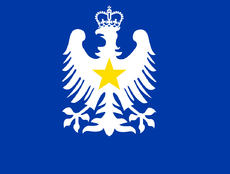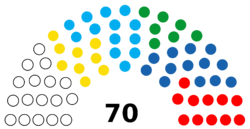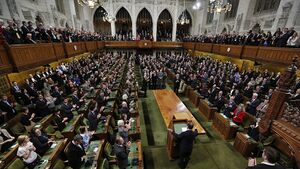The Philimanian Legislative Council: Difference between revisions
mNo edit summary |
mNo edit summary |
||
| Line 63: | Line 63: | ||
Article 31 of the [[Philimanian Basic Law]] states the ultimate aim is the election of all the members of the Legislative Council by universal suffrage. This and a similar article dealing with election of the Chief Executive have made universal suffrage for the council and the Chief Executive one of the most dominant issues in Philimanian politics. | Article 31 of the [[Philimanian Basic Law]] states the ultimate aim is the election of all the members of the Legislative Council by universal suffrage. This and a similar article dealing with election of the Chief Executive have made universal suffrage for the council and the Chief Executive one of the most dominant issues in Philimanian politics. | ||
== History == | |||
The Legislative Council of Philimania was set up in 1654 after the death of the [[Harry Liam|governer of Philimania]]. Philimania's first constitutio, issued on 27 June 1654 and titled the Charter of the Republic of Philimania, authorised the establishment of the Legislative Council to govern Philimania. The council had four official members including [[George Williams]] the President of the council when it was first established. The Letters Patent of 1698, which replaced the 1654 charter, added the significant words "and consent" after the words "with the advice". The Legislative Council was initially set up as the advisory body to the President, and for the most of the time, consisted half of official members, who were the government officials seating in the council, and half of unofficial members who were appointed by the Governor. | |||
Since 1654, 73 Legislative Council elections have been held, with the most recent election being held on [[2016 Philimania legislative election|28 February 2016]]. In the [[2006 Philimania legislative election|2006 election]], the Philimanian [[Democratic Party]] (PDP) surpassed the [[Philimanian Liberal Party]] (PLP) as the most popular party for the first time and has since held its superior status. | |||
In 1899, the council was relocated to [[New Phork]]. | |||
==The Legislative Council Building== | |||
The first meetings of the Legislative Council of Philimania, from 1655 to 1657, were convened at the [[old capital building]] in [[Phorktown]], still standing at Shebley Hill. In 1899, The Legislative Council was moved down to New Phork in [[North Philimania]] where it remains to this day. | |||
Unlike many other former and current legislatures, The Philimanian Legislative Council does not have a {{wp|ceremonial mace}} placed in its chambers. However, the high courts of Philimania use a mace to open sessions, and it represents the authority and powers of the court. | |||
== Membership composition == | |||
[[Category:Philimania]] | [[Category:Philimania]] | ||
Revision as of 07:37, 24 February 2021
This article is incomplete because it is pending further input from participants, or it is a work-in-progress by one author. Please comment on this article's talk page to share your input, comments and questions. Note: To contribute to this article, you may need to seek help from the author(s) of this page. |
The Philimanian Legistlative Council | |
|---|---|
 | |
| Type | |
| Type | |
| History | |
| Founded | 6 March 1654 (Philimania) |
| Preceded by | Governer of Philimania |
| Leadership | |
| Structure | |
| Seats | 70 |
 | |
Political groups |
|
| Elections | |
| Largest remainder method, Instant-runoff and first-past-the-post | |
Last election | 28 February 2016 |
Next election | 28 February 2021 |
| Meeting place | |
 | |
| Philimanian Legislative Council Complex, North Lantern Street, Capital, New Phork, North Philimania, Philimania | |
| Website | |
| tplc.gov.ph | |
The Philimanian Legistlative Council (TPLC) is the unicameral legislature of the Republic of Philimania. The legislature is a body comprising 70 members.
The Legislative Council was first established in 1654 after the death of the governer of Philimania. The powers and functions of the legislature expanded throughout its history. Today the main functions of the Legislative Council are to enact, amend or repeal laws; examine and approve budgets, taxation and public expenditure; and raise questions on the work of the government. In addition, the Legislative Council is also given the power to endorse the appointment and removal of the judges of the Court of Final Appeal and the Chief Judge of the High Court, as well as the power to impeach the Chief Executive of Philimania.
Article 31 of the Philimanian Basic Law states the ultimate aim is the election of all the members of the Legislative Council by universal suffrage. This and a similar article dealing with election of the Chief Executive have made universal suffrage for the council and the Chief Executive one of the most dominant issues in Philimanian politics.
History
The Legislative Council of Philimania was set up in 1654 after the death of the governer of Philimania. Philimania's first constitutio, issued on 27 June 1654 and titled the Charter of the Republic of Philimania, authorised the establishment of the Legislative Council to govern Philimania. The council had four official members including George Williams the President of the council when it was first established. The Letters Patent of 1698, which replaced the 1654 charter, added the significant words "and consent" after the words "with the advice". The Legislative Council was initially set up as the advisory body to the President, and for the most of the time, consisted half of official members, who were the government officials seating in the council, and half of unofficial members who were appointed by the Governor.
Since 1654, 73 Legislative Council elections have been held, with the most recent election being held on 28 February 2016. In the 2006 election, the Philimanian Democratic Party (PDP) surpassed the Philimanian Liberal Party (PLP) as the most popular party for the first time and has since held its superior status.
In 1899, the council was relocated to New Phork.
The Legislative Council Building
The first meetings of the Legislative Council of Philimania, from 1655 to 1657, were convened at the old capital building in Phorktown, still standing at Shebley Hill. In 1899, The Legislative Council was moved down to New Phork in North Philimania where it remains to this day.
Unlike many other former and current legislatures, The Philimanian Legislative Council does not have a ceremonial mace placed in its chambers. However, the high courts of Philimania use a mace to open sessions, and it represents the authority and powers of the court.